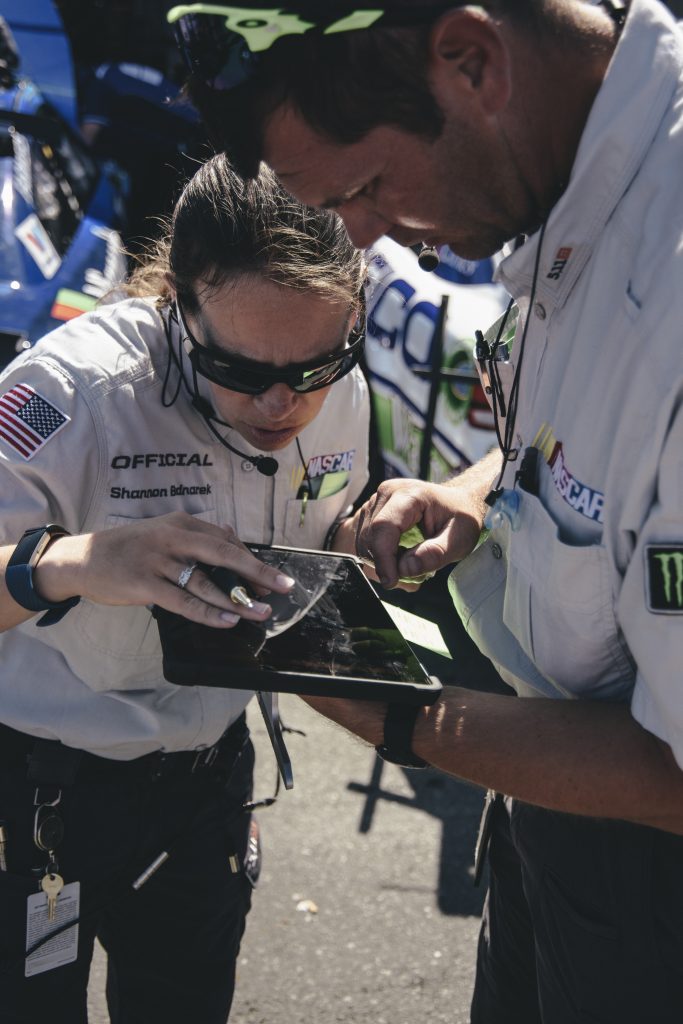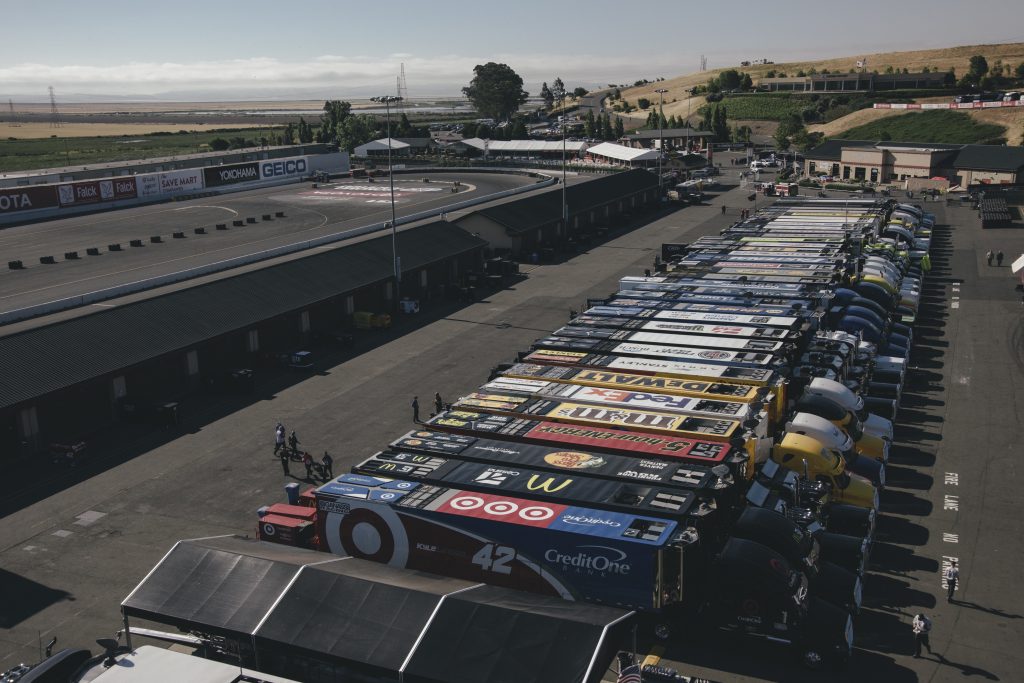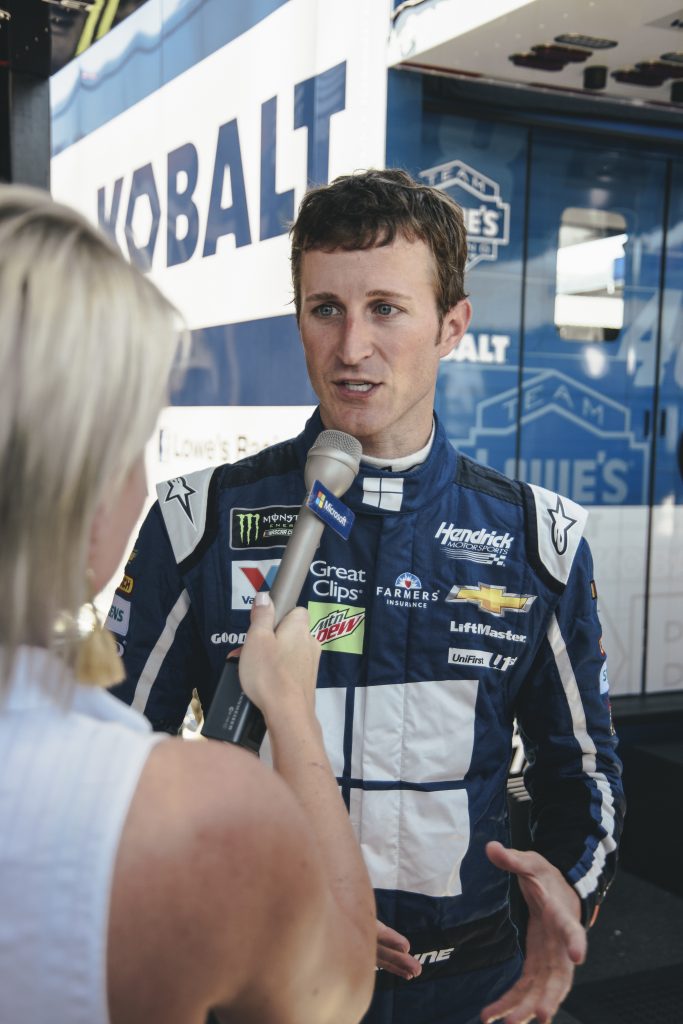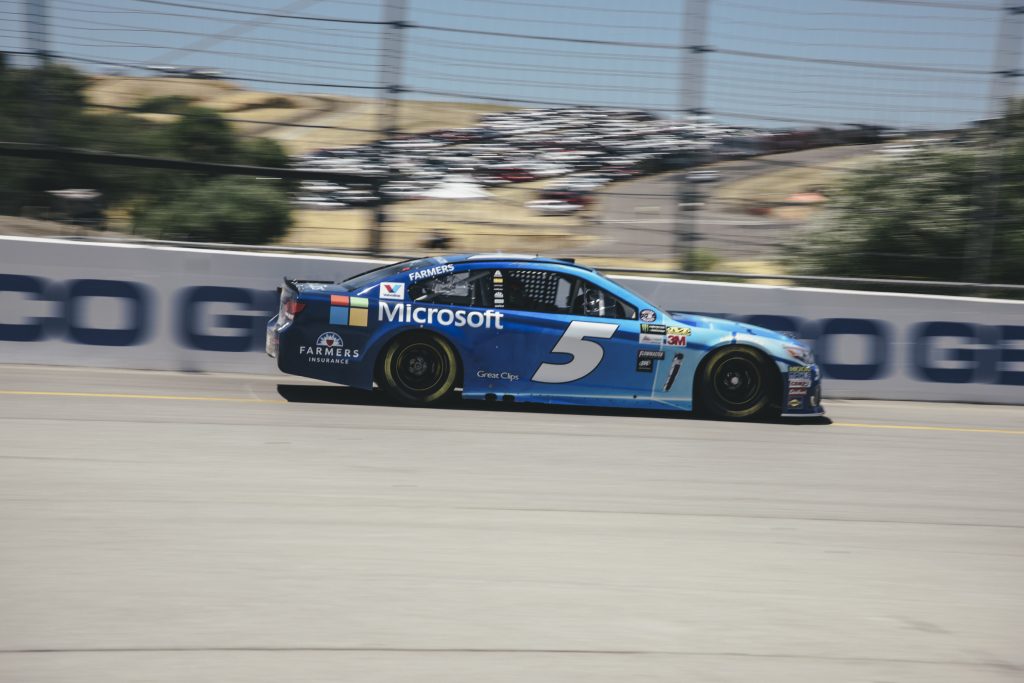NASCAR’s drive to digitally transform helps fuel a new ‘tech age’ across the sports landscape
It’s race day. On the 1.99-mile road course, 38 cars roar in a blazing blur of team colors and engine thunder. Midway through the event, a NASCAR official peers into that speedy swirl to find one specific car due for a pit stop.
“Sounds simple, right? It can take a minute,” said John Probst, NASCAR managing director of competition innovation. “Even five to 10 seconds is a long time in our sport. Every second counts.”
Now, there’s a tool to do that task in true NASCAR style – fast. With the race management app, built by NASCAR and Microsoft on Windows 10, race officials can click on a car number and instantly see that driver’s position on the track – or learn when the car got fresh tires or will next stop for fuel. NASCAR officially launched it Sunday for the Toyota/Save Mart 350 at Sonoma Raceway.
The app, introduced in 2016, includes new components like “freeze the field,” which combines video and positioning that helps NASCAR break down live race video and post-race footage to spot when and exactly where cars were located on the track. Officials also can use the app to see – on a single window – how much time the race has been run under green, yellow and red flags; how many cars are in the garage; and whether pit road penalties occurred.

“Running a race requires many people consuming data from many different sources and then coordinating that information into a seamless operation,” Probst said. “Historically, this information and data has been presented in a piecemeal form – little bits of information spread across many monitors or printed on individual sheets of paper.
“With the race management app, we are able to combine all of this information and present it to officials in a logical way. One application, one display,” Probst said.
Within NASCAR, officials are adopting new technologies to make their races fairer and safer – while also leveraging Microsoft tools like SharePoint to move their Super Bowl-sized event from city to city, 38 times a year. And at Hendrick Motorsports, 12-time NASCAR Cup Series champions, engineers are increasingly tapping tech to snip off fractions of seconds from pit stops and lap times.
In fact, decades of innovation within motor sports have helped lead the tech boom now rumbling throughout the larger sports landscape, from soccer to golf to high school football. It is a milestone moment, expert say, as more leagues, teams and competitors apply tools like Azure Machine Learning and Microsoft artificial intelligence solutions to achieve a singular goal: winning.
Intelligent guesses and gut instincts alone don’t cut it any longer on the track or on the field of play. Top performers are capturing and organizing the tremendous reservoir of raw data generated by their races and games – then using tools like predictive analytics to make smarter decisions, said Mike Downey, director of sports technology engineering at Microsoft.
Tech age in sports
“You could describe the current wave of tech transformation as a pivotal moment across all of sports. It’s up there with the Industrial Revolution and the Iron Age,” Downey said. “It’s the tech age in sports. It’s huge, and hugely transformational.”
Microsoft Consulting Services partnered with NASCAR to develop the race management app on Windows 10, with data and video stored in Microsoft’s Azure cloud platform. The app combines into one screen six data categories – historical data, timing and scoring, pit road officiating, video replay and car positioning.
From the people who officiate the action on the track to those managing everything from the safety vehicles in the Race Control hub, the app is streamlining operations, said Betsy Grider, managing director of technology development at NASCAR.
“When you have incidents on track or big wrecks, it’s high pressure, high stress,” Grider said. “After safety and medical situations are taken care of, you want to get those cars back to racing as soon as possible. Using a master app that allows you to jump in and out of different functions live, that puts everything (that’s happening) on one single pane of glass, it really helps operationally.”
Policing the pits
NASCAR has also integrated Microsoft Surface Dial into the app. The hardware tool is the size of a hockey puck and works with Microsoft Surface Studio and Surface Pro to activate hidden software features, freeing up hands for other tasks. NASCAR race officials are using Surface Dial in the app’s “infraction video” feature, which captures video to monitor pit stops for violations, said Stephen Byrd, NASCAR director of technology integration and development.
“We can now have multiple officials review and scrutinize these videos, using the Dial to play the clip on a granular level, frame by frame, so they can analyze what happened in real time, literally saving us seconds,” Byrd said. “That’s important because we want to be able to issue a penalty before that car (in violation) makes a full, complete lap. Time is of the essence.”
When the race is done, the work really starts. NASCAR is not a light packer. The entire race event –communication and broadcast hubs, cars, computers and camshafts – gets assembled and hauled in tractor-trailers to the next track in the next city for the next race.

“Just imagine lifting up three square city blocks of Manhattan and trying to move them around the country. The logistical operation compares to what you might see in the Olympics or the Super Bowl. But we’re doing it every weekend,” Grider said.
To pull all of that together, NASCAR employees stay in communication through Microsoft SharePoint, which offers a secure place to store, share, organize and access information from almost any device. (NASCAR is headquartered in Daytona Beach, Florida.) They also use Microsoft Office 365, a cloud-connected service that includes Exchange Online for email, SharePoint Online for collaboration and a suite of Office Web Apps.
‘The tech is staggering’
For NASCAR’s most decorated team, Hendrick Motorsports, technology fuels how crew chiefs and engineers hammer out race strategy, make decisions about the cars and manage crucial race-day communications.
“The technology in this sport now is staggering,” said Taylor Moyer, a race engineer with Hendrick Motorsports. He’s one of three engineers who work on the No. 5 Chevrolet SS driven by Kasey Kahne.

Three weeks before each race, Moyer and the other engineers begin compiling a large report on the track, the car and other aspects of the looming competition. They upload all their files into Microsoft OneDrive, which allows them to store, share and sync their information to the cloud. Throughout race weekend, as they gather data from Friday practices and Saturday qualifying runs, they continue building that report, Moyer said.
“We live on Microsoft Teams, OneNote and OneDrive. That allows us to have connectivity at all times. It also allows us to have a personal life, which is a huge thing because, even on our days off, we have to be able to communicate with the shop,” Moyer said. “I wake up, have my morning coffee and eggs on the porch, and work on a (race) simulation. I can drop it in OneDrive, it shows up at the shop, and the other engineers have it.
“The whole time we’re at the track, we’re also dumping files in there. And you have that report everywhere – on your phone, on the morning van ride in,” Moyer said. “It allows us to do so much more with the time we have. The only thing you can’t get more of is time.”
Then there’s the race-planning info he shares with Kahne, who carries a Microsoft Surface tablet equipped with OneDrive.
“Drivers get pulled everywhere for different obligations, but all that time he and I are in constant communication,” Moyer said. “When I’m done with my work – race prep for him – I’ll drop it in his OneDrive file. He can be sitting at home with Tanner, his son. When Tanner goes to bed, he can just open it up and there’s my work. It’s so easy.”
The files they share touch on strategy for the upcoming race. They also include data from previous races Kahne ran at that track – or races run there by the other three Hendrick Motorsports drivers: Jimmie Johnson, Dale Earnhardt Jr. and Chase Elliott. Items they discuss may include lap times, speed, tire pressures and temperatures, wear on the vehicle, plus previous driver comments on steering, throttle and braking.
After Kahne reads and assesses that info, he often chats with Moyer via the flexible, chat-based workspaces within Microsoft Teams.

“Taylor really feeds me a majority of the information that I’m looking for each week – our plan and how we can best attack the race weekend,” Kahne said. “We’re looking back at prior races at that track, what we did to the car to make it go fast and how to use some of those items again.
“It really gives me a head start going into a race weekend. Then, I can keep track of it all weekend long (via OneDrive) and know exactly what the guys are doing to be prepared and set for the race on Sunday.”
On race day, Moyer sits atop the pit box and uses Teams as a digital communications hub amid the roaring engines and frantic competition. For example, as Kahne is driving down pit road, Moyer and the team’s fueler have a quick fueling decision to make—one that could win the race. On their screens, they read fuel consumption data and chat about the fuel’s weight, its volume and the car’s speed – a precise relationship. When Kahne stops his No. 5 car, the fueler pumps in a precise amount of fuel and Kahne is quickly back on the track.
But in that frantic moment, the technology shaved precious seconds off the decision and the pit stop.
“If I can get the data out of the race car faster, I can make a decision faster,” Moyer said. “I absolutely wouldn’t be able to do my job without these tools.”
To learn more about Microsoft’s passion for improving sports performance, visit the Official Microsoft Blog.
Top image: Kasey Kahne drives the No. 5 Chevrolet SS at Sonoma Raceway. Photo by Integrated Talent.








